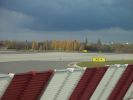
After the aircraft touches down on the runway, it must slow down and then taxi to the gate that it was assigned by the air traffic controllers at the airport. Each airport has an extensive network of taxiways, which are paths connecting runways with the other parts of the airport. In Prague, taxiways are called by a letter or a set of two letters, as in Taxiway B (pronounced Taxiway Bravo or just Bravo) or Taxiway AA (pronounced Alpha Alpha). You can see the signs near the taxiways on the following picture: Taxiway Alpha Alpha is to the right close to us, junction Alpha One is in the background, and Taxiway Alpha is all the way in the back, extending both to the left and to the right.
The airplanes are limited to a very low speed when taxiing and the pilots need a clearance from the ground controllers before they can move anywhere. The traffic on airports is usually very busy, so all the movement on the ground - including but not limited to planes, vehicles, and people - must be coordinated by a controller in order to prevent any accidents. During our tour, the bus driver had to follow special precautions when travelling through the taxiways and especially when crossing the Runway 13/31. I really wish everyone was so careful when driving on the streets.
The next picture shows an Airbus A320-211, or the Sierra India aircraft of British Airways, or British Airways flight 855, or Speedbird 8-5-5, taxiing on Ruzyně. (It's taxiing from the gate towards Runway 06 for takeoff.) As you must have noticed in the first sentence, there are many ways how airliners can be called. In this case, Airbus A320-211 is the manufacturer and type of the aircraft. Each aircraft has a registration number (almost like a lisence plate for cars); in this case, it is G-BUSI and you can read it on multiple places of the fuselage and wings. To identify an aircraft inside an airline, usually the last two letters of the registration are used. In this case, S and I - or phonetically Sierra India (those letters are usually painted on the nose wheel bay door). Each flight (not aircraft), scheduled or not, is assigned a flight number. The British Airways flight from Prague to Heathrow on Sunday around 12:50 (slightly delayed this time) has been assigned the number 855 by British Airways, hence British Airways flight 855. And when pilots communicate with Air Traffic Control, they usually use a callsign of their airline followed by the flight number. Call sign has usually some connection to the airline name or history and in case of British Airways, it's Speedbird, so this flight is referred to as Speedbird Eight Five Five in radio communication.
Trivia: I'm sure you all know the term Air Force One - that is also a callsign of the airliner providing transport of the US president.
To make it easier to understand sequences of letters over radio communication, pilots and controllers use a phonetic alphabet. Each letter is assigned a word that it starts with and instead of the letter, that word is used. The words are Alpha, Bravo, Charlie, Delta, Echo, Foxtrot, Golf, Hotel, India, Juliett, Kilo, Lima, Mike, November, Oscar, Papa, Quebec, Romeo, Sierra, Tango, Uniform, Victor, Whiskey, X-ray, Yankee, and Zulu. So for example, an aircraft registration DGL would be pronounced Delta Golf Lima. Numbers are pronounced one figure at a time in the following way (mostly the same way as in English): One, Two, Three, Fower, Fife, Six, Seven, Eight, Niner, Zero.
The center of a taxiway is marked with a yellow line. This makes it much easier for pilots to follow the way, especially in curves and on junctions. The lines will lead the pilot all the way to the stand (or later to the runway, or to another taxiway, or anywhere else). To allow the jet bridge (more about this in the next chapter) to be attached to the gate, the pilots must stop very precisely on the specified position; the tollerance is usually just a few centimeters. If you think it's easy, try stopping your car exactly on a line! Fortunately, the pilots have instruments to help them. The expected position of the nose wheel is marked on the ground for each type of aircraft (so you can see a line marked A319/320, a line marked B737, and so on at each stand). Older airports use a simple mirror attached to the airport building, allowing the pilots to see the nose wheel and the marks on the ground, newer airports, including Prague, have an electronic system containing a digital panel mounted on the terminal building that displays the distance the pilots must still travel before stopping. You can see such a panel on the following picture, just left of the yellow "1" sign.
Stands on airports are marked by yellow signs. Each stand contains not only its number, but also coordinates that the pilots can enter to their on-board GPS equipment.
Copyright notice: Text and images copyright by Michal Řeháček.